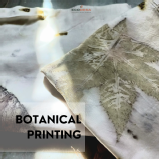This slow, meditative program empowers students to master the art of eco-printing - the sustainable practice of dyeing fabrics using natural plant-based pigments. Through hands-on workshops, in-depth material exploration, and the development of an eco-printed fashion/textile collection, students will learn to harness the beauty and versatility of this environmentally-conscious dyeing technique.
Key Topics:
- History and principles of eco-printing
- Exploring natural dye sources from plants, flowers, and foliage
- Hands-on workshops in eco-printing techniques
- Experimenting with mordants, modifiers, and different fabric substrates
Learning Objectives:
- Gain a comprehensive understanding of eco-printing as a sustainable dyeing technique.
- Develop proficiency in a range of eco-printing methods and material explorations.
- Learn to incorporate eco-printing into fashion and textile design processes.
- Explore ways to scale eco-printing for viable commercial applications
- Build a portfolio showcasing innovative eco-printed textile and fashion pieces
Why Eco-printing?
- Connection to Nature: Eco-printing encourages mindfulness by engaging with natural materials and processes. It fosters a deeper appreciation for plant life and ecosystems.
- Sustainability: Uses natural dyes and avoids harmful chemicals, making it a sustainable art form. Encourages the use of found materials, reducing waste and promoting recycling.
- Creativity and Self-Expression: Provides a unique way to express creativity through fabric and paper art. Each piece is unique, allowing for endless experimentation with colours and patterns.
- Therapeutic Benefits: The slow process can be meditative, helping to reduce stress and anxiety. Engaging in a hands-on activity promotes focus and calmness.
- Skill Development: Develops skills in natural dyeing, textile manipulation, and design. Challenges participants to think critically about materials and techniques.
- Community Building: Participating in workshops or groups fosters community and connection with like-minded individuals. Learning traditional techniques can connect individuals to cultural histories and practices.
- Educational Opportunities: Teaches about local flora, ecosystems, and sustainable practices. Connects to historical textile arts and their significance across cultures.
By embracing eco-printing, we can cultivate a richer relationship with nature, enhance their creative skills, and contribute to a more sustainable future.












